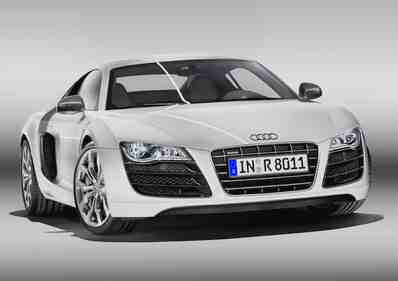 With superior Audi technologies such as quattro all-wheel drive,
the lightweight aluminum body, the innovative all-LED headlights, and its
striking design, the R8 V10 takes pole position against the competition.
The R8 V10 is the result of cumulative know-how from Audi's string of Le
Mans victories. Its naturally aspirated engine combines racing technology
such as dry sump lubrication with FSI gasoline direct injection. The ten-cylinder
design is the perfect synthesis for impressive top performance, mighty pulling
power, and low weight. Starting in 2009, this engine will also prove its
potential on the world's racetracks - in the new R8 racing car Audi is developing
for customer teams in conformance with the GT3 rules. The V10 engine in the
production sports car will be almost identical in construction to the one
in the racing version. Its displacement is 5,204 cc, at 6,500 rpm it delivers
530 Nm (390.91 lb-ft) of torque, at
8,000 rpm its power tops out at 386 kW (525 hp). The specific power
output is 100.9 hp per liter of displacement - and each hp has to propel
only 3.09 kilograms (6.91 lb) of weight, because the Audi R8 V10 in the version
with the six-speed manual gearshift weighs only 1,620 kilograms (3571 lb).
The engine accounts for 258 of these kilograms (569 lb) - that's only 31
kilos (68 lb) more than the V8. The Audi R8 5.2 FSI quattro rockets from
zero to 100 km/h (62.14 mph) in 3.9 seconds. In the version with the sequentially
shifting R tronic it reaches 200 km/h (124.27 mph) in another 8.1 seconds.
Even then its propulsive power hardly lessens: it's sufficient to reach a
top speed of 316 km/h (196.35 mph). The immense force, the spontaneity and
the thrust of the acceleration, plus the sound of the engine - all these
impressions coalesce into a breathtaking sports car experience. The V10 plays
a concert with growling bass tones and powerful high notes, which grows into
a grandiose fortissimo as the engine revs up. This sonorous acceleration
doesn't reach its limit until 8,700 rpm. The 5.2-liter powerplant uses direct
injection according to the FSI principle developed by Audi. A common rail
system injects the fuel into the combustion chambers with up to 120 bar of
pressure. Direct injection reduces the susceptibility to knocking and provides
a certain amount of cooling through the evaporation of the fuel, which in
turn supports a high compression ratio of 12.5:1. This in turn contributes
to superior performance and improves fuel economy. The R8 V10 with R tronic
gets by on an average of 13.7 liters per 100 km (17.17 US mpg). With superior Audi technologies such as quattro all-wheel drive,
the lightweight aluminum body, the innovative all-LED headlights, and its
striking design, the R8 V10 takes pole position against the competition.
The R8 V10 is the result of cumulative know-how from Audi's string of Le
Mans victories. Its naturally aspirated engine combines racing technology
such as dry sump lubrication with FSI gasoline direct injection. The ten-cylinder
design is the perfect synthesis for impressive top performance, mighty pulling
power, and low weight. Starting in 2009, this engine will also prove its
potential on the world's racetracks - in the new R8 racing car Audi is developing
for customer teams in conformance with the GT3 rules. The V10 engine in the
production sports car will be almost identical in construction to the one
in the racing version. Its displacement is 5,204 cc, at 6,500 rpm it delivers
530 Nm (390.91 lb-ft) of torque, at
8,000 rpm its power tops out at 386 kW (525 hp). The specific power
output is 100.9 hp per liter of displacement - and each hp has to propel
only 3.09 kilograms (6.91 lb) of weight, because the Audi R8 V10 in the version
with the six-speed manual gearshift weighs only 1,620 kilograms (3571 lb).
The engine accounts for 258 of these kilograms (569 lb) - that's only 31
kilos (68 lb) more than the V8. The Audi R8 5.2 FSI quattro rockets from
zero to 100 km/h (62.14 mph) in 3.9 seconds. In the version with the sequentially
shifting R tronic it reaches 200 km/h (124.27 mph) in another 8.1 seconds.
Even then its propulsive power hardly lessens: it's sufficient to reach a
top speed of 316 km/h (196.35 mph). The immense force, the spontaneity and
the thrust of the acceleration, plus the sound of the engine - all these
impressions coalesce into a breathtaking sports car experience. The V10 plays
a concert with growling bass tones and powerful high notes, which grows into
a grandiose fortissimo as the engine revs up. This sonorous acceleration
doesn't reach its limit until 8,700 rpm. The 5.2-liter powerplant uses direct
injection according to the FSI principle developed by Audi. A common rail
system injects the fuel into the combustion chambers with up to 120 bar of
pressure. Direct injection reduces the susceptibility to knocking and provides
a certain amount of cooling through the evaporation of the fuel, which in
turn supports a high compression ratio of 12.5:1. This in turn contributes
to superior performance and improves fuel economy. The R8 V10 with R tronic
gets by on an average of 13.7 liters per 100 km (17.17 US mpg).
For maximum dynamics: low center of gravity
engine
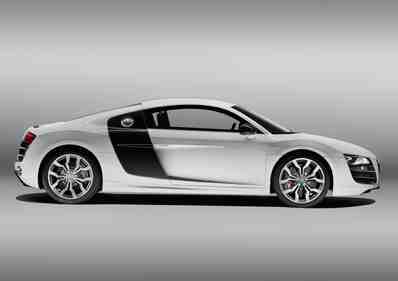 The technical refinements of the long-stroke ten-cylinder engine
include dry sump lubrication, which allows the engine to be mounted low within
the chassis. The wide cylinder angle of 90 degrees also makes for a low center
of gravity. The crankcase is a high-strength aluminum-alloy casting produced
in a complex process. The connecting rods are made of forged steel, the pistons
of aluminum. The four camshafts are chain-driven and each is adjustable through
42 degrees. This provides great latitude in controlling the valve timing.
In combination with the straight, flow-optimized ducts of the intake manifold,
this improves the charge throughout the entire speed range. The R8 5.2 FSI
quattro has a six-speed transmission. A precise and smooth-shifting manual
transmission comes as standard equipment. The sequential R tronic is available
as an option. The high-tech gearshift conveys an authentic racing feel -
with the rocker switches at the steering wheel and the short shifting times
of usually less than one-tenth of a second. When the driver actuates the
Launch Control program by pressing a button, the R8 V10 takes off in a vehement
quick-start with electronically controlled tire slip - both with the R tronic
and with the manual transmission. A contributing factor to the wide lead
in traction and driving safety of the Audi R8 V10 over the competition is
quattro all-wheel drive - it's the superior technology especially for a
high-performance sports car. Four powered wheels get more grip than two.
They enable the driver to step on the gas sooner when coming out of a curve.
It's not only the traction that benefits, but also the transverse dynamics
and the stability. The technical refinements of the long-stroke ten-cylinder engine
include dry sump lubrication, which allows the engine to be mounted low within
the chassis. The wide cylinder angle of 90 degrees also makes for a low center
of gravity. The crankcase is a high-strength aluminum-alloy casting produced
in a complex process. The connecting rods are made of forged steel, the pistons
of aluminum. The four camshafts are chain-driven and each is adjustable through
42 degrees. This provides great latitude in controlling the valve timing.
In combination with the straight, flow-optimized ducts of the intake manifold,
this improves the charge throughout the entire speed range. The R8 5.2 FSI
quattro has a six-speed transmission. A precise and smooth-shifting manual
transmission comes as standard equipment. The sequential R tronic is available
as an option. The high-tech gearshift conveys an authentic racing feel -
with the rocker switches at the steering wheel and the short shifting times
of usually less than one-tenth of a second. When the driver actuates the
Launch Control program by pressing a button, the R8 V10 takes off in a vehement
quick-start with electronically controlled tire slip - both with the R tronic
and with the manual transmission. A contributing factor to the wide lead
in traction and driving safety of the Audi R8 V10 over the competition is
quattro all-wheel drive - it's the superior technology especially for a
high-performance sports car. Four powered wheels get more grip than two.
They enable the driver to step on the gas sooner when coming out of a curve.
It's not only the traction that benefits, but also the transverse dynamics
and the stability.
44 to 56 percent - the ideal axle load
distribution
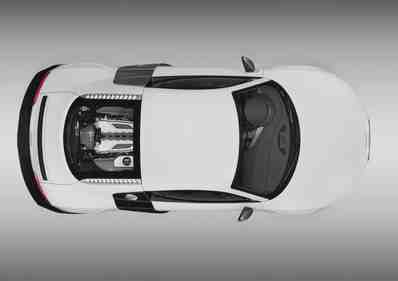 The Audi R8 chassis offers both dynamic performance and astonishing
levels of comfort on long distances. This high-performance sports car from
Audi eagerly responds to any steering action with instant ease, achieves
lateral acceleration of up to 1.2 g, and handles any situation with superb
driving safety. Its mid-engine design provides an ideal axle load distribution
of 44 to 56 percent. The wheel suspensions on dual aluminum wishbones front
and rear - a classic racing technology - are optimized for neutral self-steering
characteristics. Even more than in the eight-cylinder R8, this setup is designed
for maximum performance. 19-inch wheels equipped with tire pressure monitoring
display are standard equipment. Their 10-spoke Y design is exclusive to the
R8 V10. Tire sizes are 235/35 front and 295/30 rear. The car features a high-end
damper technology as standard: Audi magnetic ride adapts the characteristics
of the suspension in milliseconds to the nature of the road surface and to
the driving style. Suspended in the oil of the shock absorbers are tiny magnetic
particles which, when a voltage is applied, rearrange themselves so as to
slow down the flow of oil through the valves. In the R8 V10, deceleration
is provided by an extremely muscular braking system - eight brake pistons
at the front and four at the rear grasp the brake disks, which are ventilated
and perforated to ensure unimpeded heat transfer. The brake disks on the
front axle have a diameter of 380 millimeters (15 in); the rear discs span
356 millimeters (14 in). The R8 5.2 FSI quattro is optionally available with
a ceramic brake system whose disks are made of a composite material containing
high-strength carbon fibers and abrasion-resistant silicon carbide. These
are especially light: their combined weight is nine kilograms (19.84 lb)
less than the weight of equivalent steel disks. The ceramic brakes can easily
cope with the harsher requirements of racing, won't corrode, and have a typical
service life of 300,000 kilometers (186,400 miles). Their calipers are painted
charcoal gray and emblazoned with the inscription "Audi ceramic". The Audi R8 chassis offers both dynamic performance and astonishing
levels of comfort on long distances. This high-performance sports car from
Audi eagerly responds to any steering action with instant ease, achieves
lateral acceleration of up to 1.2 g, and handles any situation with superb
driving safety. Its mid-engine design provides an ideal axle load distribution
of 44 to 56 percent. The wheel suspensions on dual aluminum wishbones front
and rear - a classic racing technology - are optimized for neutral self-steering
characteristics. Even more than in the eight-cylinder R8, this setup is designed
for maximum performance. 19-inch wheels equipped with tire pressure monitoring
display are standard equipment. Their 10-spoke Y design is exclusive to the
R8 V10. Tire sizes are 235/35 front and 295/30 rear. The car features a high-end
damper technology as standard: Audi magnetic ride adapts the characteristics
of the suspension in milliseconds to the nature of the road surface and to
the driving style. Suspended in the oil of the shock absorbers are tiny magnetic
particles which, when a voltage is applied, rearrange themselves so as to
slow down the flow of oil through the valves. In the R8 V10, deceleration
is provided by an extremely muscular braking system - eight brake pistons
at the front and four at the rear grasp the brake disks, which are ventilated
and perforated to ensure unimpeded heat transfer. The brake disks on the
front axle have a diameter of 380 millimeters (15 in); the rear discs span
356 millimeters (14 in). The R8 5.2 FSI quattro is optionally available with
a ceramic brake system whose disks are made of a composite material containing
high-strength carbon fibers and abrasion-resistant silicon carbide. These
are especially light: their combined weight is nine kilograms (19.84 lb)
less than the weight of equivalent steel disks. The ceramic brakes can easily
cope with the harsher requirements of racing, won't corrode, and have a typical
service life of 300,000 kilometers (186,400 miles). Their calipers are painted
charcoal gray and emblazoned with the inscription "Audi ceramic".
Typically Audi: Sharp lines and an elegantly
curved roof
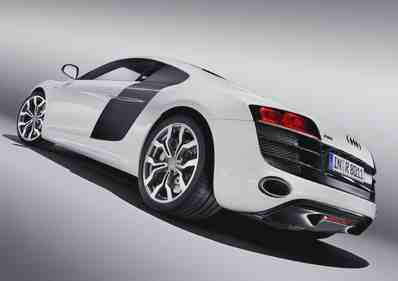 The wide, full shape of the R8 5.2 FSI quattro seems to hug
the road. The brawny proportions and prominent wheel wells underscore its
potential. The high-precision styling of the lines and the elegant curve
of the roof are typical Audi features. A continuous contour optically connects
the front, the wheel wells, the sides and the rear. Located well forward,
the cab visually expresses the mid-engine design. The vertical air scoops
(sideblades) on the sides are also indicative of the engine location. The
massive aluminum gas cap is mounted flush within the right sideblade. The
design of the Audi R8 has already impressed experts, as evidenced by the
double victory in the "World Car of the Year Awards 2008". In the ten-cylinder
model, the styling has been sharpened up even more. The front air inlets,
which feed air to the coolers, and the lip of the front apron are painted
in high-gloss black. The number of cross-braces has been reduced from four
to two. The vanes of the single-frame grille have a striking chrome finish.
A very distinctive highlight of the R8 V10 are the all-LED headlights as
standard equipment. Audi is the world's first automaker to use LEDs for the
high beam, low beam, daytime running lights, and turn signals. Each headlight
integrates 54 of these high-tech light sources. With a color temperature
of 6,000 Kelvin the LED light closely resembles daylight, which is less tiring
to the eyes in night driving. Further advantages of the LEDs include brilliant
illumination, low energy consumption, and a virtually unlimited service life.
Special details also distinguish the body of the R8 V10. Its sideblades are
more accentuated than in the eight-cylinder version. The side sills are more
striking and wider; the exhaust grilles at the rear windows have a matt aluminum
look. Through the large rear window, the ten-cylinder engine is clearly visible
in its consummate technical beauty. When in motion, this Audi high-performance
sports car creates a downforce that keeps it in firm contact with the road
- thanks to a rear spoiler which deploys automatically at 100 km/h and the
fully enclosed underbody, which terminates in a sharply upward-curved diffuser.
The dominant color at the rear end is high-gloss black, including the settings
of the LED tail lights. The air outlets at the rear end also have only two
cross-braces, and the exhaust system terminates in two large oval tailpipes. The wide, full shape of the R8 5.2 FSI quattro seems to hug
the road. The brawny proportions and prominent wheel wells underscore its
potential. The high-precision styling of the lines and the elegant curve
of the roof are typical Audi features. A continuous contour optically connects
the front, the wheel wells, the sides and the rear. Located well forward,
the cab visually expresses the mid-engine design. The vertical air scoops
(sideblades) on the sides are also indicative of the engine location. The
massive aluminum gas cap is mounted flush within the right sideblade. The
design of the Audi R8 has already impressed experts, as evidenced by the
double victory in the "World Car of the Year Awards 2008". In the ten-cylinder
model, the styling has been sharpened up even more. The front air inlets,
which feed air to the coolers, and the lip of the front apron are painted
in high-gloss black. The number of cross-braces has been reduced from four
to two. The vanes of the single-frame grille have a striking chrome finish.
A very distinctive highlight of the R8 V10 are the all-LED headlights as
standard equipment. Audi is the world's first automaker to use LEDs for the
high beam, low beam, daytime running lights, and turn signals. Each headlight
integrates 54 of these high-tech light sources. With a color temperature
of 6,000 Kelvin the LED light closely resembles daylight, which is less tiring
to the eyes in night driving. Further advantages of the LEDs include brilliant
illumination, low energy consumption, and a virtually unlimited service life.
Special details also distinguish the body of the R8 V10. Its sideblades are
more accentuated than in the eight-cylinder version. The side sills are more
striking and wider; the exhaust grilles at the rear windows have a matt aluminum
look. Through the large rear window, the ten-cylinder engine is clearly visible
in its consummate technical beauty. When in motion, this Audi high-performance
sports car creates a downforce that keeps it in firm contact with the road
- thanks to a rear spoiler which deploys automatically at 100 km/h and the
fully enclosed underbody, which terminates in a sharply upward-curved diffuser.
The dominant color at the rear end is high-gloss black, including the settings
of the LED tail lights. The air outlets at the rear end also have only two
cross-braces, and the exhaust system terminates in two large oval tailpipes.
Audi sets the example - in body weight and
rigidity
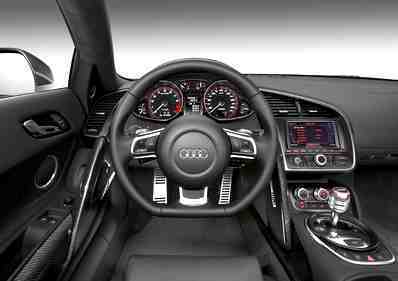 The body of a sports car must be especially lightweight and
rigid. Audi meets these requirements with the technology of the Audi Space
Frame (ASF) and its high-tech aluminum construction. The body-in-white of
the R8 V10, which includes an engine frame made of ultra-light magnesium,
weighs only 210 kilograms (463 lb), and the quality of its lightweight design
- the relation of weight to torsional rigidity - is the best in the sports
car segment. The body is composed of profile extrusions, sheet aluminum and
very complex gusset castings, all held together by 99 meters (325 ft) of
welding seams, 782 rivets, and 308 special screws. The interior of the R8
V10 provides a unique racing ambience at the luxury level. Its dominant element
is the so-called monoposto - a wide arc that contains the steering wheel
and the cockpit. As always in an Audi, the workmanship is of the highest
quality. The surfaces of the dashboard and doors are lined with fine materials
and adorned with precisely stitched decorative seams. Many customizing solutions
are available: Audi supplies leather in a wide range of colors, packages
with a carbon and piano-lacquer finish, or a made-to-measure luggage set.
quattro GmbH, which has developed and is producing the R8 V10, also provides
solutions for unconventional requirements. The body of a sports car must be especially lightweight and
rigid. Audi meets these requirements with the technology of the Audi Space
Frame (ASF) and its high-tech aluminum construction. The body-in-white of
the R8 V10, which includes an engine frame made of ultra-light magnesium,
weighs only 210 kilograms (463 lb), and the quality of its lightweight design
- the relation of weight to torsional rigidity - is the best in the sports
car segment. The body is composed of profile extrusions, sheet aluminum and
very complex gusset castings, all held together by 99 meters (325 ft) of
welding seams, 782 rivets, and 308 special screws. The interior of the R8
V10 provides a unique racing ambience at the luxury level. Its dominant element
is the so-called monoposto - a wide arc that contains the steering wheel
and the cockpit. As always in an Audi, the workmanship is of the highest
quality. The surfaces of the dashboard and doors are lined with fine materials
and adorned with precisely stitched decorative seams. Many customizing solutions
are available: Audi supplies leather in a wide range of colors, packages
with a carbon and piano-lacquer finish, or a made-to-measure luggage set.
quattro GmbH, which has developed and is producing the R8 V10, also provides
solutions for unconventional requirements.
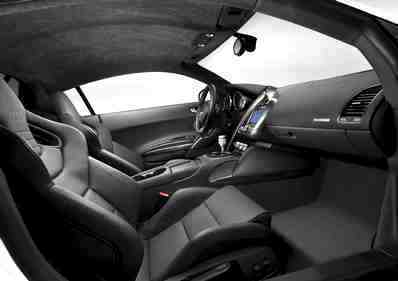 The great everyday utility of the Audi R8 V10 is based in part
on its spacious interior made possible by the long wheelbase of 2.65 meters
(8.69 ft). Drivers and passengers of any size will always find a perfect
sitting position. Visibility too is surprisingly good. Slender hinge pillars
optimize the obliquely forward field of view. Another advantage for convenient
everyday use is the luggage space: 100 liters (3.53 cu ft) fit under the
front hood, another 90 liters (3.18 cu ft) can be stowed behind the seats.
There is also room for two golf bags. The Audi R8 5.2 FSI quattro combines
its colossal performance with a generous complement of standard equipment.
Highlights include heatable seat covers made of Fine Nappa leather, a driver
information system, the navigation system plus and the Bang & Olufsen
sound system along with deluxe automatic air conditioning and an alarm system.
The instruments and the gearshift knob are decorated with red rings; the
footrests and the rocker switches of the R tronic have an aluminum finish.
The list of options includes other highly attractive features - such as the
Audi parking system advanced with its integrated rearview camera or numerous
Audi exclusive customization options. Various leather packages provide a
luxurious touch, while the bucket seats from the Audi exclusive program bring
a highly concentrated racing atmosphere into the R8 V10. The Audi R8 5.2
FSI quattro will be rolled out in Germany in the second quarter of 2009 at
a basic price of EUR 142,400. The great everyday utility of the Audi R8 V10 is based in part
on its spacious interior made possible by the long wheelbase of 2.65 meters
(8.69 ft). Drivers and passengers of any size will always find a perfect
sitting position. Visibility too is surprisingly good. Slender hinge pillars
optimize the obliquely forward field of view. Another advantage for convenient
everyday use is the luggage space: 100 liters (3.53 cu ft) fit under the
front hood, another 90 liters (3.18 cu ft) can be stowed behind the seats.
There is also room for two golf bags. The Audi R8 5.2 FSI quattro combines
its colossal performance with a generous complement of standard equipment.
Highlights include heatable seat covers made of Fine Nappa leather, a driver
information system, the navigation system plus and the Bang & Olufsen
sound system along with deluxe automatic air conditioning and an alarm system.
The instruments and the gearshift knob are decorated with red rings; the
footrests and the rocker switches of the R tronic have an aluminum finish.
The list of options includes other highly attractive features - such as the
Audi parking system advanced with its integrated rearview camera or numerous
Audi exclusive customization options. Various leather packages provide a
luxurious touch, while the bucket seats from the Audi exclusive program bring
a highly concentrated racing atmosphere into the R8 V10. The Audi R8 5.2
FSI quattro will be rolled out in Germany in the second quarter of 2009 at
a basic price of EUR 142,400.
At a glance |

